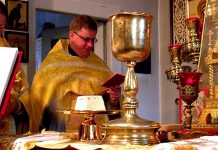The Christmas story has become synonymous with the date, December 25. Whether you’re listening to carols or looking at nativity scene imagery, the idea that Christmas is His birthday is everywhere. But what has become popular belief isn’t exactly true to history.
The Gospel of Matthew and the Gospel of Luke are the only two accounts of Jesus’ birth in the New Testament, and both gospels show different angles of the story. Luke begins in Nazareth and Matthew focuses solely on events in Bethlehem. Both aren’t particularly detailed in terms of a calendar date, which makes determining Jesus’ birthday quite tough. The writers of the gospels rarely tell you when things happened and the time of year.
“The Bible does not specify a date or a month when Jesus was born.”
The Bible does not specify a date or a month when Jesus was born. There are many different theories as to why Christmas is celebrated on December 25. A very early Christian tradition said that the day when Mary was told that she would have a very special baby, Jesus (called the Annunciation) was on March 25 – and it’s still celebrated on the day. Nine months after that date is December 25. Others believe Christmas is celebrated on this day because it was already popular in ancient religious celebrations as the birthday of the sun. The Winter Solstice and the ancient festival day celebrating the return of the sun ‘Saturnalia’ and ‘Dies Natalis Solis Invicti’ took place in December around this date. While December 25 was popularized as the date for Christmas, it was not because Jesus was born on that day. If you take a close look at Scripture, it indicates that this is an unlikely date for Christ’s birth. Although it’s not impossible, it seems unlikely that Jesus was really born on December 25. Here are several key reasons.
We Know That Shepherds Were in the Fields Watching Their Flocks at the Time of Jesus’ Birth
Scripture tells us that, “ gave birth to her firstborn, a son. She wrapped Him in cloths and placed Him in a manger, because there was no guest room available for them. And there were shepherds living out in the fields nearby, keeping watch over their flocks at night” (Luke 2:7-8). But shepherds were not in the fields during December. Luke’s account suggests that Jesus may have been born in summer or early fall. In December, Judea is cold and rainy, so it is likely the shepherds would have sought shelter for their flocks at night. The weather would not have permitted shepherds watching over their flocks in the field at night.
Jesus’ Parents Came to Bethlehem to Register in a Roman Census
The census or enrollment which according to Luke 2:1 was the occasion of the journey of Joseph and Mary to Bethlehem where Jesus was born, is connected with a decree of Augustus, embracing the Greek-Roman world. Luke carefully distinguishes the census at the time of Jesus’ birth as “first,” in a series of enrollments connected wither with Quirinius or with the imperial policy inaugurated by the decree of Augustus. Because temperatures often dropped below freezing and roads were in poor conditions, the census was not taken in winter. This time of year didn’t permit it.
Winter Would Be a Difficult Time for Mary to Travel
Mary was traveling the long distance from Nazareth to Bethlehem which was about 70 miles. Winter would likely be an especially difficult time for a pregnant Mary to travel such a long distance. The world of Mary and Joseph was a difficult and dangerous place, one whose harsh conditions were not fully chronicled in the Gospel accounts of their travails. Writers of the gospels of Matthew and Luke “are so laconic about the event because they assume the reader would know what it was like,” said James F. Strange, a New Testament and biblical archaeology professor at the University of South Florida in Tampa. “We have no idea how difficult it was.” Strange estimates that Joseph and Mary likely would have traveled only 10 miles a day because of Mary’s impending delivery.
The time of year that Jesus was born continues to be a huge subject of debate, particularly the month of Jesus’ birth. Many biblical scholars believe Scripture points to the fall of the year as the most likely time of Jesus’ birth. In 2008, astronomer Dave Reneke argued that Jesus was born in the summer. Reneke told New Scientist the Star of Bethlehem may have been Venus and Jupiter coming together to form a bright light in the sky. Using computer models, Reneke determined that this rare event occurred on June 17, in the year 2 B.C. Other researchers have claimed that a similar conjunction, one between Saturn and Jupiter occurred in October of 7 B.B., making Jesus an autumn baby.
Theologians have also suggested that Jesus was born in the spring, based on the biblical narrative that shepherds were watching over their flocks in the fields on the night of Jesus’ birth – something they would have done in the spring, not the winter. The Bible nowhere points to Jesus being born in mid-winter. Unfortunately, nobody really knows exactly when Jesus was born.
www.beliefnet.com
Claim: The day celebrated as Christmas (December 25) is the actual birthday of Jesus.
Origins: The biblical narrative of Jesus’ birth gives no date for the event, though it more likely occurred in spring than in winter. Saint Luke tells us that
shepherds were “abiding in the field, keeping watch over their flocks by night” — shepherds guarded their flocks day and night only at lambing time, in the spring; in winter, the animals were kept in corrals, unwatched.
It is important to note that for two centuries after Christ’s birth, no one knew, and few people cared, exactly when he was born. Birthdays were unimportant; death days counted. Besides, Christ was divine and his natural birth was deliberately played down. In fact, the Church even announced at one point that it was sinful to contemplate observing Christ’s birthday “as though He were a King Pharoah.”
The idea of celebrating the Nativity on December 25 was first suggested early in the fourth century CE, a clever move on the part of Church fathers who wished to eclipse the December 25 festivities of a rival pagan religion,
Mithraism, which threatened the existence of Christianity.
On December 25 (the date of the winter solstice) pagan Romans, still in the majority, celebrated Natalis Solis Invincti, “Birthday of the Invincible Sun God,” Mithras. The Mithras cult originated in Persia and rooted itself in the Roman world in the first century BCE, but by the early 300s CE the rising religion of Christianity was posing a formidable challenge to the sun worshipers, especially after the Edict of Milan issued by the Roman emperor Constantine I in 313 CE allowed Christians to practice their faith in the Roman Empire.
In those tenuous early days of Christianity, however, Church fathers debated strategies for supplanting the Mithras cult with their own religion. Since it was well known that Roman patricians and plebians alike enjoyed festivals of a protracted nature, Christians recognized that they needed an alternative to the December celebration of Natalis Solis Invincti. They needed a celebration in which all participants — Mithraists, Christians, and those in between — could take part with pride. Accordingly, the Church officially recognized Christ’s birth, and to offer head-on competition to the sun worshipers’ popular feast, the Church located the Nativity on December 25. The mode of observance would be characteristically prayerful: a Mass. In fact, Christs’ Mass. As one theologian wrote around 320 CE:
We hold this day holy, not like the pagans because of the birth of the sun, but because of him who made it.
Although centuries later, social scientists would write of the psychological power of group celebrations — the unification of ranks, the solidification of collective identity, the reinforcement of common objectives — the principle had long been intuitively obvious. Christianity took permanent hold in the Western world in 337 CE when Constantine I was baptized on his deathbed, uniting for the first time the Crown and the Church.
Last updated: 30 July 2007
Sources:
Panati, Charles. Sacred Origins of Profound Things. New York: Penguin Books, 1996. ISBN 0-14-019533-5 (pp. 215-217).
Varasdi, J. Allen. Myth Information.
New York: Ballantine Books, 1989. ISBN 0-345-35985-2 (pp. 59-61).
Published 6 December 2007
www.snopes.com
Although millions of people celebrate the birth of Jesus Christ on Dec. 25, most scholars agree that he wasn’t born on that day, or even in the year 1 A.D.
Researchers believe the Roman Catholic Church settled on Dec. 25 for many reasons, such as that date’s ties to the winter solstice and Saturnalia, a festival dedicated to the Roman deity Saturn. By choosing this day to celebrate Jesus’ birthday, the church could co-opt the popular pagan festival, as well as the winter celebrations of other pagan religions.
But nobody really knows exactly when Jesus was born.
Some scholars think that he was born between 6 B.C. and 4 B.C., based partly on the biblical story of Herod the Great. Not long before Herod’s demise, which is believed to have occurred in 4 B.C., the ruler of Judea supposedly ordered the death of all male infants who were under the age of two and lived in the vicinity of Bethlehem, in an attempt to kill Jesus.
But historians disagree about Herod’s actual year of death. What’s more, the horrific mass infanticide is legend, not fact, Reza Aslan, a biblical scholar and author of “Zealot: The Life and Times of Jesus of Nazareth” (Random House, 2013), told PolicyMic.
To pinpoint Jesus’ birth year, other scholars have tried to correlate the “Star of Bethlehem,” which supposedly heralded Jesus’ birth, with actual astronomical events. For example, in a 1991 article in the Quarterly Journal of the Royal Astronomical Society, astronomer Colin Humphreys proposed that the fabled star was actually a slow-moving comet, which Chinese observers recorded in 5 B.C.
Scholars also debate the month of Jesus’ birth. In 2008, astronomer Dave Reneke argued that Jesus was born in the summer. The Star of Bethlehem, Reneke told New Scientist, may have been Venus and Jupiter coming together to form a bright light in the sky. Using computer models, Reneke determined that this rare event occurred on June 17, in the year 2 B.C.
Other researchers have claimed that a similar conjunction, one between Saturn and Jupiter, occurred in October of 7 B.C., making Jesus an autumn baby.
Theologians have also suggested that Jesus was born in the spring, based on the biblical narrative that shepherds were watching over their flocks in the fields on the night of Jesus’ birth — something they would have done in the spring, not the winter.
Follow Joseph Castro on Twitter. Follow us @livescience, Facebook & Google+.
www.livescience.com








